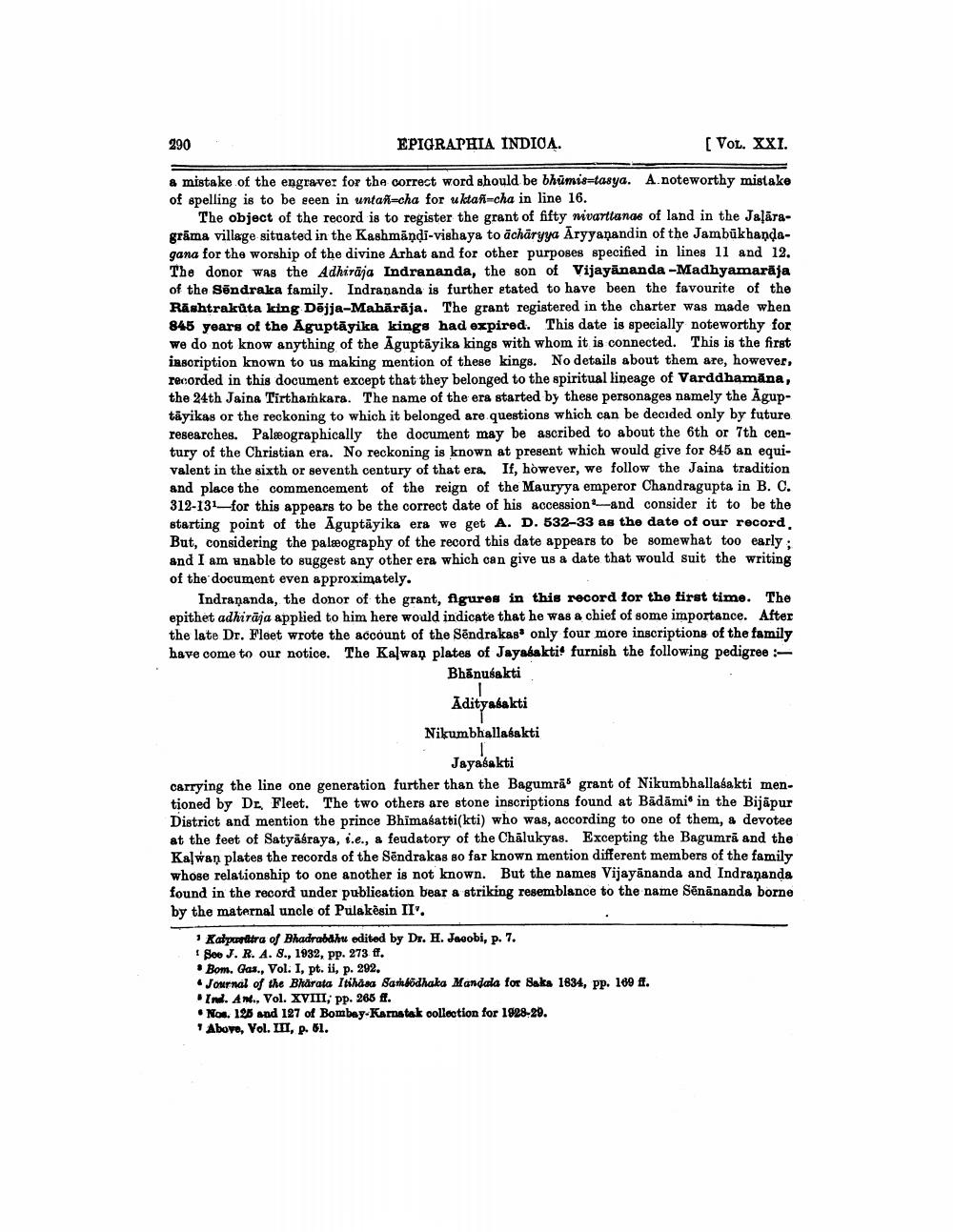________________
290
EPIGRAPHIA INDICA.
[VOL. XXI.
a mistake of the engraver for the correct word should be bhumis-tasya. A.noteworthy mistake of spelling is to be seen in untañ-cha for uktañ-cha in line 16.
The object of the record is to register the grant of fifty nivarttanas of land in the Jalāragrāma village situated in the Kashmandi-vishaya to acharyya Aryyanandin of the Jambukhandagana for the worship of the divine Arhat and for other purposes specified in lines 11 and 12. The donor was the Adhiraja Indrananda, the son of Vijayananda -Madhyamarāja of the Sendraka family. Indrananda is further etated to have been the favourite of the Rashtrakuta king Dējja-Mahārāja. The grant registered in the charter was made when 845 years of the Aguptayika kings had expired. This date is specially noteworthy for we do not know anything of the Aguptayika kings with whom it is connected. This is the first inscription known to us making mention of these kings. No details about them are, however, recorded in this document except that they belonged to the spiritual lineage of Varddhamana, the 24th Jaina Tirthamkara. The name of the era started by these personages namely the Aguptayikas or the reckoning to which it belonged are questions which can be decided only by future. researches. Palæographically the document may be ascribed to about the 6th or 7th century of the Christian era. No reckoning is known at present which would give for 845 an equivalent in the sixth or seventh century of that era. If, however, we follow the Jaina tradition and place the commencement of the reign of the Mauryya emperor Chandragupta in B. C. 312-131 for this appears to be the correct date of his accession and consider it to be the starting point of the Aguptayika era we get A. D. 532-33 as the date of our record. But, considering the paleography of the record this date appears to be somewhat too early; and I am unable to suggest any other era which can give us a date that would suit the writing of the document even approximately.
Indrananda, the donor of the grant, figures in this record for the first time. The epithet adhiraja applied to him here would indicate that he was a chief of some importance. After the late Dr. Fleet wrote the account of the Sendrakas only four more inscriptions of the family have come to our notice. The Kalwan plates of Jayasakti furnish the following pedigree :
Bhanusakti I Adityasakti Nikumbhallasakti I
Jayasakti
carrying the line one generation further than the Bagumras grant of Nikumbhallaśakti mentioned by Dr. Fleet. The two others are stone inscriptions found at Badami in the Bijapur District and mention the prince Bhimasatti(kti) who was, according to one of them, a devotee at the feet of Satyasraya, i.e., a feudatory of the Chalukyas. Excepting the Bagumra and the Kalwan plates the records of the Sendrakas so far known mention different members of the family whose relationship to one another is not known. But the names Vijayananda and Indrananda found in the record under publication bear a striking resemblance to the name Sēnānanda borne by the maternal uncle of Pulakesin II'.
1 Kalparitra of Bhadrabahu edited by Dr. H. Jacobi, p. 7.
See J. R. A. 8., 1932, pp. 273 ff.
Bom. Gas., Vol. I, pt. ii, p. 292.
Journal of the Bharata Itihasa Sambodhaka Mandala for Saks 1834, pp. 169 ff.
Ind. Ant., Vol. XVIII, pp. 265 ff.
Nos. 125 and 127 of Bombay-Karnatak collection for 1928-29.
"Above, Vol. III, p. 51.




